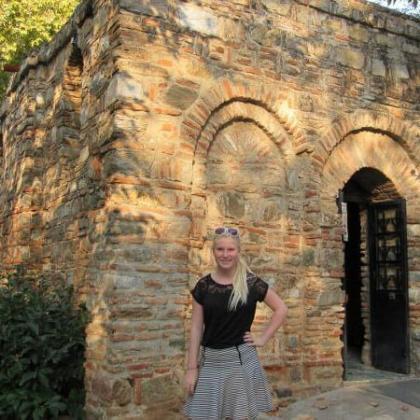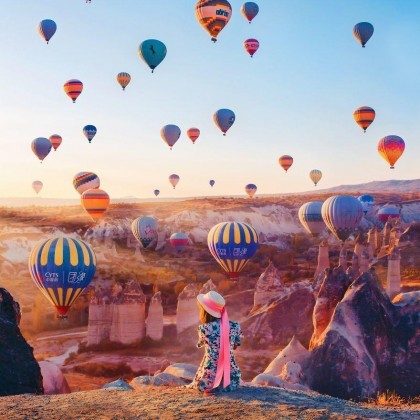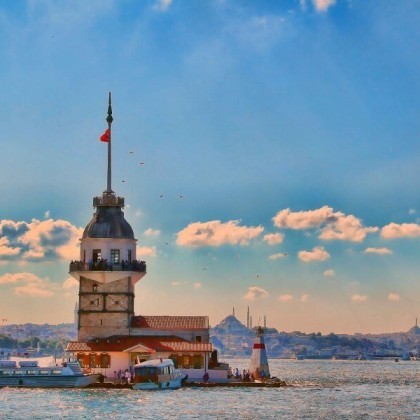Amasya
Towering cliffs, a quiet river, carved rock tombs, and stately Ottoman houses are all part of Amasya’s fortuitous meeting of human and natural architecture. In older areas, the town’s pedestrian streets and waterfront houses suggest something like a Turkish Venice, despite the rugged surroundings. Today, Amasya has a relaxed atmosphere. It is most striking when the rock tombs are illuminated at night, towering above the mellow groups drinking çay or enjoying Amasya’s famous apples.
The birthplace of the geographer Strabo (roughly 63 BC), Amasya was the capital of Pontus, a kingdom of Greek-speaking Persians that arose after the death of Alexander the Great. After a series of costly wars with the Romans, the city was razed by Pompey in 64 BC. Rebuilt as a provincial capital, the town flourished under the Romans and Byzantines before falling in 1071 to the Selçuks, who left a legacy of Islamic monuments. Under the Ottomans, who arrived in 1391, Amasya became a theological and cultural center, with 18 medresesi by the 18th century.
Istanbul New Year’s Eve Party Cruise on the Bosphorus
IstanbulWith this new year's eve party program in Istanbul, you will have an amazing new year party on the Bosphorus. Book it now and don't miss the special price!
View Tour3 Days Ephesus, Pergamon and Pamukkale Tour Package
Ephesus, Pamukkale, PergamonIf you want to make an amazing trip to the Ephesus, Pergamon, and Pamukkale, you should read our tour itinerary.
View TourIstanbul and Cappadocia Tour – 7 Days
Istanbul, Cappadocia, TurkeyIf you want to make a trip to Istanbul and Cappadocia both, we strongly suggest you join this amazing package tour. This tour covers all the accommodations, transportations, lunches...
View TourBest of Turkey Package Tour – 8 Days
Istanbul, Cappadocia, Ephesus, PamukkaleAre you looking for a good traveling package in Turkey? With our 8-days Turkey tour, you will make a trip to every important sight in Turkey. Enquire now for...
View TourTRANSPORTATION
Buses: Arriving buses stop at either the city center or the otogar (218 80 12), 3km northeast of town. The larger bus companies provide a free servis shuttle to the city center. Otherwise, to get to the center, take any of the city buses ($.30, students $.25) or dolmuş ($.35, students $.30) that stop across the street from the otogar. Some companies will drop you along Atatürk Bul. if they are not terminating in Amasya. Follow this road 600m or so and then turn left to reach the river and center of town. Dolmuş run to the otogar from behind the Atatürk statue in the main square. Otherwise, turn left at the otogar’s exit and follow the road straight to the city center. Try to flag down a passing bus heading toward Samsun or Tokat. Buses run from the otogar to; Ankara (5hr.; 7 per day 8:30am-12:30am; $9.50, students $8); Antalya (12hr.; 3pm; $22, students $19); Bursa (11hr.; 3 per day 6:30-8pm; $19, students $16); Çorum (1hr., frequent, $3); Denizli (12hr.; 4pm; $19, students $16); Diyarbakır (12hr.; 4 per day 7:30- 11:30pm; $19, students $17.50); Erzurum (9V2hr.; 9:30pm; $19, students $16);
BLACK SEA COAST
Istanbul (10hr.; 9 per day 9:30am-11:15pm; $19, students $16); İzmir (14hr.; 4 per day at 5pm; $22.50, students $21); Kayseri (8hr., 13 per day, $11); Marmaris (15hr.; 4pm; $22.50, students $19); Samsun (2hr.; 8am, 11:30pm; $3); Sivas (4hr., 12 per day 8am-11:30pm, $3); Tokat (4hr., 12 per day 8am-11;30pm, $3); Trabzon (8hr.; 5 per day 5-10pm; $13, students $11).
Trains: The gar (218 12 39), on the north bank, is about 2km west of the main square. To get to town, take one of the dolmuş ($.35) or buses ($.30) that stop across the street. Alternatively, turn left out of the station, cross the first bridge, and take another left onto Mustafa Kemal Paşa Cad., which becomes Atatürk Cad. and runs through the center of town. To Samsun (3hr.; daily 4:55am; Tu, Th, Sa-Su 2pm; $1.25) and Sivas (4hr.; Su-M, F midnight; $2.25). 60% discount for students and travelers over 60.
ORIENTATION AND PRACTICAL INFORMATION
Amasya is divided by the Yeşilırmak (Green River), which runs roughly east-west. The north bank, home to Ottoman houses and the cliff tombs of the Pontic Kings, is the older part of town. The tourist office and most restaurants and hotels lie on the south bank, either on Mehmet Paşa Cad., the road running immediately along the river, or the more substantial Atatürk Cad., running parallel one block farther south. The city center (şehir merkezi), which sits between these two roads, is a large plaza with an Atatürk monument.
- Banks: Many with ATMs line the south bank of the river. Yapı ve Kredi, just across the street from the PTT, cashes traveler’s checks and has a Cirrus/MC/Plus/V ATM. Open M-F 9am-12:30pm and l:30-5pm. TC Ziraat Bankasi (218 41 53), on Siyat Paşa Bul., will also change traveler’s checks. Open M-F 8:30am-6pm.
- Hamams: Mustafabey Hamamı (218 34 61), just off Mehmet Paşa Cad., 50m east of the tourist office. Divides its single 550-year-old dome between the sexes. Bath $1.50 for women, $2 for men; kese $1.25. Open for women 11am-5pm, for men 5-11pm. The 13th-century Yıldız Hamamı (218 15 94) is across from the Zümrüt Otel on Hazeranlar Sok and a short walk from the entrance to the Pontic tombs. Married couples can enter a private bathing area. Bath $1.50 for women, $2 for men; kese $1.25; massage $.70. Open daily 6am-midnight.
- Hospital: Devlet Hastanesi (218 40 00), on Mustafa Kemal Paşa Cad.
- Internet Access: Nokta internet Cafe, 10 Belediye Dükkanlar (218 89 73), next to the Yimpaş grocery on Yavuz Selim Meydanı. $.75 per hr. Open daily 9am-midnight. PTT: On Mehmet Paşa Cad., 100m west of the main square. Open daily 8:30am- 12:30pm and l:30-5pm. Phone card sales and services 8am-11pm.
Postal Code: 05100
ACCOMMODATIONS
Amasya’s exquisite hotels in restored Ottoman houses sit near more functional, budget accommodations. Expect prices to be slightly steeper here. Though the two Ottoman inns along the river are more expensive than most lodgings in Amasya, their beautiful views and traditional decor make them worth the extra expense. Reservations arc recommended during July and August.
IS ilk Pension, Gümüşlü Nah., 1 Hitit Sok. (218 16 89; fax 218 62 77), down a small side street off Mehmet Paşa Cad., near the Yimpaş supermarket and across the street from the tourist office. Restored by Its architect-owner, the 180-year-old pension offers 6 large, decorated rooms. Breakfast $3. Singles $17-34; doubles $25-45.10% student discount. There’s also a 25% discount for architects 45 years and older.
IS Emin Efendi Pension, Hatoniye Mah., 73 Hazeranlar Sok. (212 08 52; fax 212 18 95), on the north bank of the river. Cross over the bridge by the PTT, turn left, and continue 300m. Housed in a 200-year-old Ottoman house, the 5 rooms share a bath, and all have a magical view of the river. Singles $22; doubles $33; triples $39.
Yuvam Pansiyons 1 and 2, 24/1 Atatürk Cad. (218 13 42; fax 218 34 09), to the left of the main square when facing the river. The first is an apartment building with 14 clean rooms, 11 with bath. Breakfast $3. Singles $9.50, with bath $11.50; doubles $16, with bath $19. The second pension, farther from the town center but more comfortable, is only open if there are enough guests. Breakfast $3. Singles $13; doubles $26; triples $38. Camp in the garden: $4 per tent; $6.50 to use their single tent; $13 for the 2-person tent. Both pensions have kitchens and washing machines ($4 per load), and a 10% student discount.
Yalıboyu Otel, 19/D Ziyapaşa Bul. (»218 70 29). Each sparkling room in this brand new hotel offers TV and private bath. Excellent rooftop restaurant (Amasya kebap $2.50; Efes beer $1.50). Breakfast included. Singles $8, with bath $10; doubles $16, $18 with bath; triples $24, $25 with bath.
Zümrüt Otel, 28 Hazeranlar Sok. (»218 17 69; fax 212 35 54), on the way to the Emin Efendi Pension. Offers 12 cheap rooms with TV and fridge. 4 with river views, 9 with showers. Access to kitchen and stunning rooftop terrace. Very friendly. Breakfast included. $9.50 per person, students $8.
FOOD
Amasya’s several kebap and pide restaurants are filled all day with locals escaping the sun, sipping tea, and taking in the scenery. If you’re in more of a do-it-yourself mood, stock up at Yimpas, a supermarket just across the street from the tourist office. (Open daily 8am-10pm.)
A masya Şehir Demeği Restaurant, 1 Karşıkaya Mah., 1 Tevfik Hafiz Sok., Vilayet Önü (218 10 13), in the Öğretmen Evi (teachers’ hostel) on the north riverbank, across the bridge from the Atatürk statue. A great terrace just above the river, although the menu is somewhat thin. Kuzu dolma iç pilav $3. Open daily 1 lam-midnight.
Ocakbaşı Restaurant, 5 Ziya Paşa Cad. (218 56 92). Face the river from the PTT; turn left on Ziya Paşa Cad. (along the river Mazeranlar Konagi Karşı Geçesi). Serves standard Turkish dishes in an outdoor plaza. Lahmacun $.50. Open daily 6am-midnight.
SIGHTS
THE MUMMIES AND THE ARCHAEOLOGICAL MUSEUM
This museum has an impressive collection of artifacts spanning the history of the region. Note the stunning arabesques on the original door of the Selçuk Gök Medrese and the grisly mummified remains of Mongol rulers and their children, on display in the old Selçuk türbe (tomb). (Just past the Sultan Beyazıt Mosque on Atatürk Cad. Open Tu-Su 8:30am-noon and l:30-5:30pm. $1, students $.50.)
PONTIC TOMBS
Carved out of the cliffs north of the city are the now-empty Kralkaya mezarları, the tombs of the Pontic kings. Though the graffiti-covered tombs are less impressive up close than from below, a climb up offers beautiful panoramic views of the valley and city. At the same site you’ll also find the scanty ruins of the palace of the Pontic kings, known as the Kızlar Sarayı, or Palace of the Maidens. The site draws its name from the harems that were a part of the palace complex. (Cross the bridge by the PTT and follow the yellow signs up the hill to the Kralkaya mezarları. Open daily 8:30am-8pm. $1.50, students $.75.) If you really catch tomb fever, head to the Aynalı Mağara (Mirror Cave), a few kilometers northeast of town. As the tomb is not enclosed, you can walk all the way around it to see how’ it was completely cut away from the rock. (It’s a substantial walk on foot; from the south bank, follow Mehmet Paşa Cad. east past the tourist office, then cross the river at the next bridge, and follow Zübeyde Hamm Cad. to a large roundabout with signs to the tomb. Alternatively, take a $4 round-trip taxi from town.)
FORTRESS
The ancient 3rd-century BC kale looms high above the city. It wras renovated first by the Ottomans and again in the 1980s. The extensive ruins and spectacular view’s of the entire gorge are worth the long and steep hike. Look for the Cilanbolu (secret passage), with 150 steps carved into the rock situated at the top. (From Zubeyde Hamm Cad., on the north bank, follow signs marked “Kale.” The walk from the city center takes about 45min.-lhr.; if you’re in a hurry, catch a cab for about $4 oneway.)
OTTOMAN HOUSE MUSEUM (HAZERANLAR KONAĞI)
This museum, on the north side of the river opposite Otel Zümrüt, is one of Amasya’s best-preserved Ottoman houses, along with the Ilk and Emin Efendi Pansiyons. These houses are characterized by wooden or half-timber exteriors and upper floors that extend out over the street. Inside, the complicated floorplans often provide separate stair ways and quarters for men and women. Decoration consists of geometrically carved wooden ceilings, and, in the restored houses, kilims, carpets, and embroidered cushions. The basement houses a gallery of Turkish modem art. (Open M-F 8am-noon and l:30-5:30pm. Museum open Tu-Sa 8am-noon and l:30-5:30pm. $1.)
YILDIZ HATUN MEDRESESİ
This birmarhane, or insane asylum, 20m on the left as you exit the tourist office, was built in 1308 by the Mongol Sultan Olcaytuas as a hospital, asylum, and medical school. The intricately carved doorway and other features of the building look remarkably Selçuk, revealing the extent to which the Mongols incorporated the architectural styles of the peoples they conquered. Doctors continued to be trained at the Bimarhane up until the 19th century.
MOSQUES
Sultan Beyazıt II Camii, Amasya’s largest Islamic monument, was completed in 1486 by Sultan Beyazıt ITs eldest son and heir apparent Alunet. The side areas of the mosque were used as dervish quarters, a feature which disappeared from Ottoman architecture after about 1500. From the mosque, walk through its courtyard and up a flight of stairs to a main road and turn right onto Atatürk Cad. Continue west on Atatürk Cad. past the archaeological museum to the Selçuk Gök Medrese Camii (Blue Seminary Mosque). The blue tiles that gave the mosque its name (“gök” means “sky”) are now’ mostly gone, and the spectacular carved door has been moved to the archaeological museum. Still, the intricately carved Selçuk doorway is worth a look. The mosque was built in 1267 by Şerafettin Torumtay, governor of Amasya. lie and his family now lie buried on the mosque grounds, in the aptly named Tomb of Torumtay. Across the street is the splendid Ottoman Eli Yörgüç Paşa Camii, with striking sections of red stone and pristine frescoes. The intimate interior marks a change from the vast vaulted spaces of the larger mosques. Left along the river, with your back to the tourist office, is the early Ottoman Mehmet Paşa Camii, a sprawiing complex that houses a Quranic school for girls. (To reach the Beyazıt II Camii, follow the river 11km west from the PTT.)





